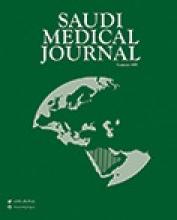Abstract
OBJECTIVE: To look at the survival pattern of extreme preterm Omani infants (23-26 weeks gestation) and compare it with the western countries.
METHODS: All extreme preterm Omani infants (gestational age of 23 to 26 weeks) admitted from November 1991 to February 1998 at the Neonatal Intensive Care Unit of Sultan Qaboos University Hospital were reviewed. The detailed records of the infants, including name of mother, age, gravidity, parity, route of delivery, Apgar score, time of birth, inborn or outborn, birth weight, gestational age, sex, need for resuscitation, course in the Neonatal Intensive Care Unit, admission and discharge diagnosis, and outcome were collected from the register. The infants were stratified according to the gestational age and then analyzed for the survival rate among the different gestational ages.
RESULTS: A total of 32 extreme preterm infants were admitted to the Neonatal Intensive Care Unit of Sultan Qaboos University Hospital from November 1991 to February 1998. The mean birth weight of the cohort was noted to be 798+123 gram (Range 480-1015 grams). The mean gestational age was noted to be 25.5+0.95 weeks (Range 23-26 weeks). An equal number of males and females were noted in the cohort, with male to female ratio of 1:1. A total of 13 infants survived out of 32 infants. The overall survival rate for the cohort was noted to be 41%. For the present study, the western statistics are averaged and than compared with the Omani statistics. The survival rate for western 26 week preterm infants was (on average) 61% as compared to 44% among Omani preterm infants. The same trend of low survival was noted for 23 and 24 week Omani infants, except for only one 25 week infant.
CONCLUSION: The significant lower survival rate suggests the need for more attention and improvement in the management and care provided to the extreme preterm Omani infants.
- Copyright: © Saudi Medical Journal
This is an open-access article distributed under the terms of the Creative Commons Attribution-Noncommercial-Share Alike 3.0 Unported, which permits unrestricted use, distribution, and reproduction in any medium, provided the original work is properly cited.






